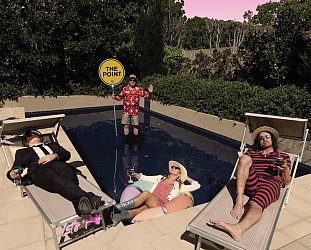Graham Reid | | 2 min read
Ennio Morricone: La Carrozza dei Fanstasmi (Carriage of the Spirits)

The relationship between some movie directors and composers is so close that it is hard to imagine certain films without their soundtracks: Hitchcock had Bernard Herrmann's gripping scores for Psycho and North by Northwest and others; Werner Herzog with the German avant-rock band Popul Vuh providing the eerie music to Aguirre, Wrath of God and Fitzcarraldo; and Sergio Leone's early spaghetti westerns with the distinctive music by Ennio Morricone.
In fact, Morricone's aural fingerprint was everywhere in westerns for almost a decade from the mid 60s, even when he wasn't writing the music. Copyists adopted elements of his signature style of twanging guitar figures, odd voices and strange found sounds such as that of a whirring wooden ruler dragged across a tabletop or the chiming of a lonely mission bell.
Morricone (born in Rome in 1928) was classically trained, wrote some contemporary classical work in his youth then turned his attention to orchestrating popular songs. He met director Leone in the early 60s and provided him with the music to A Fistful of Dollars and A Few Dollars More, both vehicles for Clint Eastwood and filmed in Spain where labour was cheap and the locations looked sufficiently like Mexico as the backdrop.
Morricone continued to work with Leone (he did many of his soundtracks up until Once Upon a Time in America in '84) but also found acclaim and Academy Award nominations for his soundtracks to Days of Heaven (by Terrence Malik, '78) and The Mission (by Roland Joffre '86). He has written numerous classical works, collaborated with the likes of Quincy Jones, and has had a significant impact on popular culture.
But it was his music for The Good, The Bad and The Ugly in 1966 -- an epic spaghetti western by Leone with anti-war themes and typically ambiguous morality -- that made his name widely known, especially when Hugo Montenegro had a pop hit with his version of the distinctive title track.
But the soundtrack is much more than simply that "wolf-call" aural shorthand: it is dramatic in its sweep, incorporates elements of Civil War-period folk melodies alongside Hispanic flourishes, paints on a canvas as wide a desert, and in L'estasi dell'oro [Ecstasy of Gold] Morricone created a piece of music which is dense, formidable and urgent -- the perfect aural accompaniment to Eli Wallach (the ugly) racing through a cemetery in a desperate search for the grave where he believes the missing gold is buried.
The counterpoint to that however is the haunting ballad La Storia de un soldato [The Story of a Soldier] which is sung when Wallach is being beaten senseless and a group of soldier/prisoners are obliged to play "with feeling" to cover up the noise.
Throughout this ambitious soundtrack -- which also is punctuated with more abstract pieces such as Due Contro Cinque included on the CD but not vinyl version -- Morricone used found sounds (tapping), whistling, gunshots, a choir, and each character has his own musical motif which is repeated throughout: that leads to the three-way showdown and the dramatic orchestrated piece which parallels the on-screen rapid cutting and tension.
On reflection Morricone borrowed from his two previous Dollars soundtracks, but here is more expansive and emotionally connected with the deeper and darker script.
Morricone's music to The Mission may be a more mature orchestral work and his Crime and Dissonance collection a seriously disturbing but also Essential Elsewhere album . . . but in The Good, The Bad and The Ugly he created a palette of sounds that others would draw on for years -- and even today that distinctive whistle in the theme is instantly recognisable.
These Essential Elsewhere pages deliberately point to albums which you might not have thought of, or have even heard . . .
But they might just open a door into a new kind of music, or an artist you didn't know of.
Or someone you may have thought was just plain boring.
But here is the way into a new/interesting/different music . . .
Jump in.
The deep end won't be out of your depth . . .







post a comment